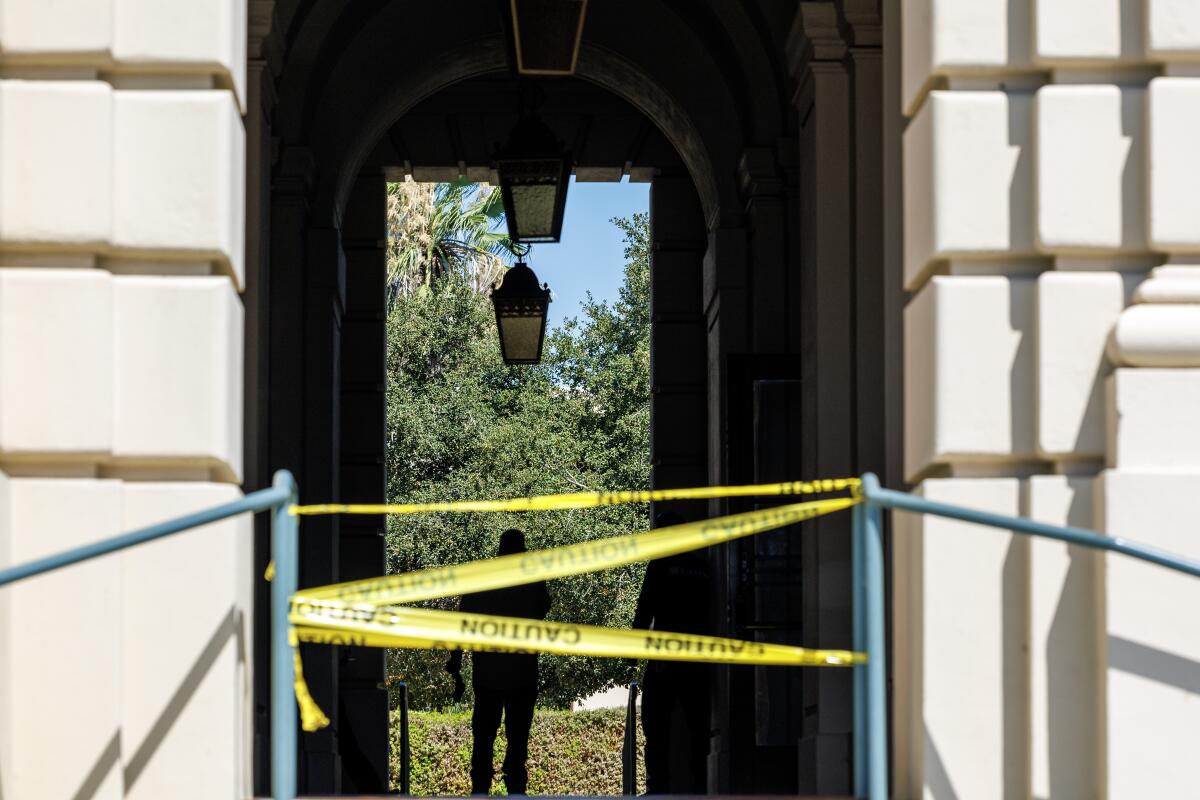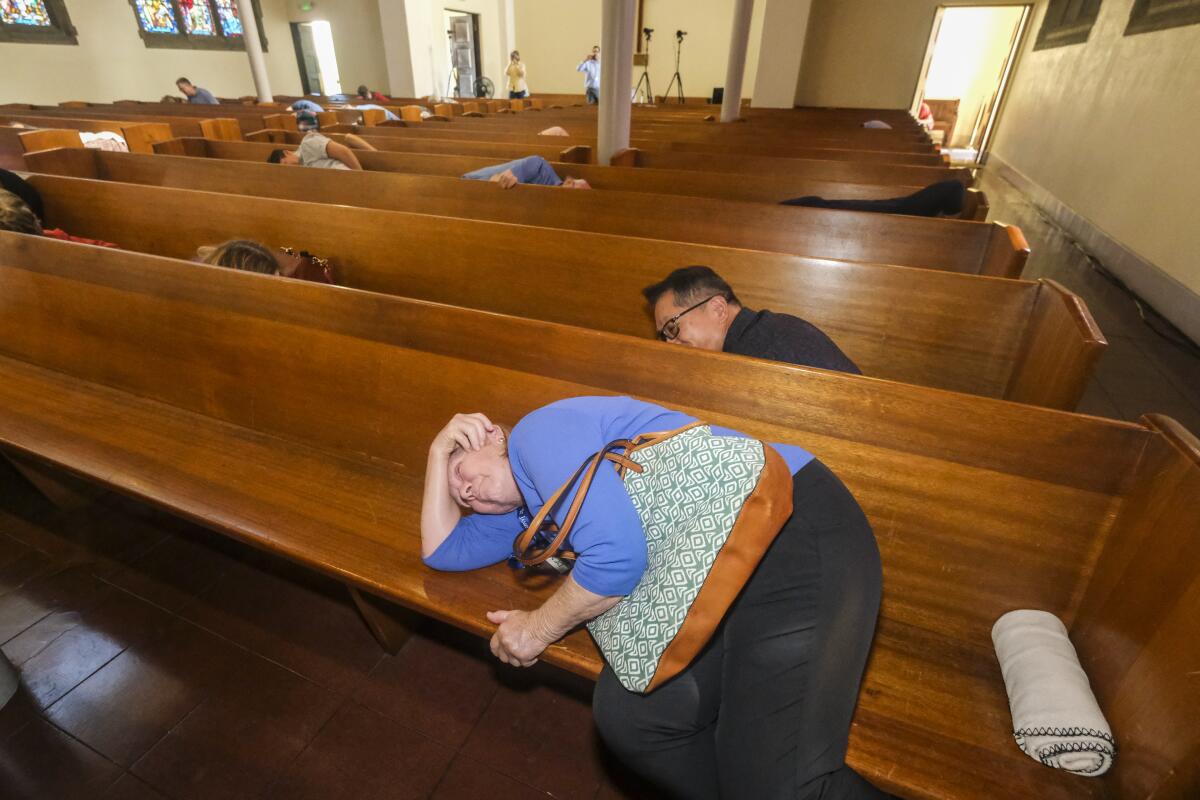More frequent earthquakes, but we’re in a ‘seismic drought’? Here’s why

Good morning. It’s Wednesday, Sept. 25. Here’s what you need to know to start your day.
- California remains in puzzling earthquake ‘drought’ despite recent shaking.
- Trump’s rhetorical walkabouts: A sign of ‘genius’ or cognitive decline?
- This magical Amtrak ride to New Mexico belongs on your winter bucket list (but book soon).
- And here’s today’s e-newspaper
Sign up for Essential California
The most important California stories and recommendations in your inbox every morning.
You may occasionally receive promotional content from the Los Angeles Times.
A busier year for earthquakes, but still a ‘seismic drought’
Los Angeles kicked off 2024 with a 4.1 magnitude quake that rattled the region, including Rose Parade attendees in Pasadena.
Less than a week later, a 4.2 temblor rippled out from the San Bernardino area. A few weeks later, another quake of the same magnitude struck about 15 miles away.
In the months since, the rattling has continued, shaking communities in Malibu; in El Centro; in Corona; in Ventura County; in Newport Beach; in Bakersfield; in the Mojave Desert; in L.A.’s historic El Sereno.
Most recently (as of this writing), a magnitude 3 temblor that caused “weak” shaking in Malibu this past Saturday.

Maybe you’ve wondered — as I did after my peaceful morning in the San Gabriel Valley was interrupted by a 4.7 quake near Malibu on Sept. 12 — why it seems quakes are rattling us more often.
Is that actually happening?
Some of my fellow Times reporters answered that question. Turns out yes, there has been an increase in moderate earthquakes rumbling the region, according to scientists.
That Sept. 12 quake near Malibu marked SoCal’s 14th seismic sequence this year that included at least one magnitude 4 or higher temblor, according to seismologist Lucy Jones, L.A.’s patron saint of earthquake info. That breaks a 65-year-old record.
But scientists note that the increased frequency “is not necessarily an indication that a large, damaging earthquake is around the corner,” my colleagues Rong-Gong Lin II, Steve Henson, Ruben Vives and Karen Garcia reported. “Some researchers have offered dueling theories — some say earthquake activity increases in a region before a large earthquake, others say seismic activity decreases before a large jolt.”
But even though we’re feeling notably more shaking this year, SoCal remains in a “seismic drought,” Ron explained, noting we have not experienced any major damaging earthquakes under the Golden State’s most populous cities in the last 30 years.
If you were alive in Southern California in 1994, chances are you remember the last time.

The 6.7 magnitude Northridge earthquake lasted about 20 seconds. Sixty people were killed and thousands more injured.
It crumpled freeways and destroyed or damaged an estimated 80,000 homes, stores and other structures. Trains derailed. Gas and water lines ruptured. Power transformers blew. Hundreds of fires broke out across the region.
The quake caused an estimated $20 billion in damage and an additional $40 billion in economic losses, according to the California Department of Conservation.
In the nearly 31 years since, we’ve fortunately lacked devastation anywhere near that magnitude. But this streak won’t last forever.
Every seismic jolt we experience should serve as a reminder that California’s next major quake is not a matter of if — it’s a matter of time.
The infamous Northridge quake isn’t even considered a “Big One.” For that, we have to go back to 1857’s Fort Tejon earthquake, a 7.9 magnitude monster on the San Andreas fault that ruptured 225 miles between Monterey and San Bernardino counties. Just one death was reported in that quake. The impact of a similarly sized temblor would be vastly different today.
“A hypothetical future magnitude 7.8 earthquake on the southern San Andreas fault, from the Mexican border to Los Angeles County, could result in 1,800 deaths and nearly 50,000 injuries, according to the U.S. Geological Survey’s ‘ShakeOut’ scenario,” Ron reported.
The Northridge quake led to major investments in seismic retrofitting and major changes in how we build things. But Ron previously reported that some California cities have largely “ignored the seismic threat … [creating] an uneven landscape that in the coming years will leave some cities significantly better prepared to withstand a big quake than others.”
As I wrote earlier this year looking back on the 30 years since Northridge, there are things we can all do to be a little more prepared. Here are a few questions to consider:
- Do you have earthquake kits and go-bags?
- Do you have a stash of canned food and bottled water?
- Do you have extra food and supplies for pets?
- Do you know your neighbors?
- Have you signed up for early warning alerts?
- Do you live or work in a building that’s at higher risk during a quake?
- Does your home need any retrofitting?
If you’re inclined to work through those questions and more, check out The Times’ handy guide on all things earthquake preparedness.
Today’s top stories

Trump’s rhetorical walkabouts: A sign of ‘genius’ or cognitive decline?
- Former President Trump calls his long and rambling speeches a sign of his “genius” for weaving together disparate facts. Others say they may mark a cognitive decline.
- A detailed study of Trump’s speeches over time found more “confused word order, and repetition, alongside extended digressions.”
- Meanwhile, this swing Central Valley congressional district will cross party lines for the “best” candidate.
- And six weeks before the 2024 election, California is having a 2026 governor’s debate.
Sean ‘Diddy’ Combs and a bodyguard drugged and raped a woman on video, a lawsuit alleges
- A woman alleges Combs and his bodyguard drugged, bound and violently raped her decades ago then later showed video of the attack to others.
- Her lawsuit comes a week after federal prosecutors in New York unsealed an indictment against Combs for sex trafficking, racketeering and prostitution.
More than 55,000 L.A. County workers could go on strike Oct. 10, a union announced
- Such a walkout may have a seismic effect on county services, affecting hospitals, social services and other county departments.
- The workers are represented by SEIU 721, which accused the county of failing to follow their labor contract. County officials called the union’s allegations “unfounded.”
A virus that can cause paralysis in children is on the rise in California
- Most people who contract the virus, known as Enterovirus D68, will experience slight respiratory symptoms or none at all. But in rare cases, it can cause polio-like paralysis in children.
- Doctors say the best way to avoid the virus is by practicing common respiratory hygiene.
What else is going on
- One person was killed after a gunman hijacked a Metro bus, leading the LAPD on a wild chase.
- Several L.A. County sheriff’s deputies were relieved of duty in connection with a federal investigation.
- L.A. County called on Yelp, Google and other online platforms to “deplatform” illegal cannabis dispensaries.
- The L.A. City Council announced a $35-million settlement with agriculture giant Monsanto and two smaller companies over waterway contamination due to PCBs.
- A judge halted construction of a massive warehouse project after scores of homes were already demolished.
- More than 125 Hollywood actors, directors, producers and others urged Gov. Newsom to sign an AI safety bill.
- Shohei Ohtani had only 16 stolen bases in June. Then he made it “a really special season.”
Get unlimited access to the Los Angeles Times. Subscribe here.
Commentary and opinions
- We should care about Robert F. Kennedy Jr.’s scandalous relationship with a journalist, columnist Robin Abcarian writes.
- Here’s how Arnold Schwarzenegger and the California recall inform the Harris-Trump race, columnist Mark Z. Barabak writes.
- The next president — whether it’s Trump or Harris — won’t have a mandate, columnist Jonah Goldberg writes.
- Wildfire scientist and author Chad Hanson looks at how a California community helped prevent the Bridge fire from destroying their town.
This morning’s must-reads
He told followers he was the son of God. She helped get him arrested on sex trafficking charges. Apollo Quiboloy was arrested in the Philippines, accused of leading a global sex trafficking conspiracy, which he denies. In California, his church is also in hot water.
Other must-reads
- A deadly knife attack on a Japanese schoolboy in China has stoked frictions between the two countries.
- The president of El Salvador claims he has cleaned up the country. But at what cost?
How can we make this newsletter more useful? Send comments to essentialcalifornia@latimes.com.
For your downtime

Going out
- 🚂 This magical Amtrak ride to New Mexico belongs on your winter bucket list (but book soon).
- 🥪 L.A. is sandwich heaven. Food critics at The Times share 37 of their favorites.
- 🛋️ Looking for affordable used furniture? Try these 11 L.A. thrift stores.
- 🩰 More adults are returning to L.A. ballet studios.
- 🧳 You might be able to read a banned book while waiting for a flight at LAX.
Staying in
- 🤣 “Saturday Night Live” is turning 50, so The Times asked actors, writers, directors and show alumni to choose their top sketch of all time. And we want to know: what is your favorite sketch?
- 📺 “Brilliant Minds” and “English Teacher” show burnout in the workplace as a constant.
- 🗳️ After Biden dropped out, the PBS series “Frontline” scrambled to update its election year documentary.
- 🥗 Here’s a recipe for okra gumbo.
- ✏️ Get our free daily crossword puzzle, sudoku, word search and arcade games.
And finally ... a great photo
Show us your favorite place in California! Send us photos you have taken of spots in California that are special — natural or human-made — and tell us why they’re important to you.
Today’s great photo is from Jim Colton of Palo Alto: Redwood National Park.
Jim writes: “Walking among these large and beautiful trees is a peaceful and humbling experience.”
Have a great day, from the Essential California team
Ryan Fonseca, reporter
Defne Karabatur, fellow
Andrew Campa, Sunday reporter
Hunter Clauss, multiplatform editor
Christian Orozco, assistant editor
Stephanie Chavez, deputy metro editor
Karim Doumar, head of newsletters
Check our top stories, topics and the latest articles on latimes.com.
For the record: Yesterday’s Essential California said a quick-moving 2023 landslide happened in Rolling Hills. It occurred in Rolling Hills Estates, a different city. The newsletter also conflated that 2023 slide with the slow-moving ongoing slide at nearby Portuguese Bend. The two slides are not related.
Sign up for Essential California
The most important California stories and recommendations in your inbox every morning.
You may occasionally receive promotional content from the Los Angeles Times.





